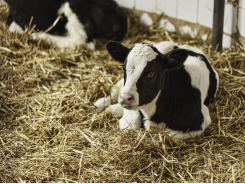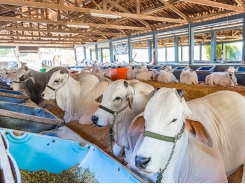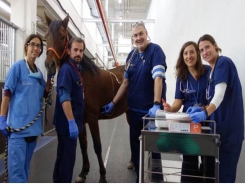Dairy system model to examine complete production cycle

A new dairy system model would trace feed influence through the complete production cycle in an effort to improve system understanding, efficiency and environmental effect.
Although the use of modeling to understand pieces of dairy cow production like nutrition and genetic selection or address areas like production efficiency are not new, there are questions that current predictive models are not able to answer, said Kristian Reed, assistant professor of dairy cattle nutrition at Cornell University.
Looking forward, the dairy industry will have to address new challenges and find solutions to issues including the influence of climate change and the need for more production without an expansion in land use, she said.
To address those topics dairy producers and researchers are going to need to start looking past the barn and “think about how what we feed dairy cattle impacts the rest of what’s going on at the farm.”
Reed is part of a group that includes researchers from the US Department of Agriculture, Cornell University, the University of Madison, University of California – Davis and the University of Arkansas seeking to develop a new process-based modeling system set to simulate and connect each element in a dairy system to start to answer some the larger questions about dairy production.
“We’re going to simulate nitrogen, phosphorus and carbon cycling in order to estimate production, greenhouse gas production, energy and water use and the losses to the environment,” she added.
“I was trying to use existing models to simulate nitrogen flows and changes in nitrogen efficiency under different management scenarios and when I tried to undertake that task I realized that the existing tools weren’t sufficient,” she told FeedNavigator. “They weren’t going to allow me to answer the questions on nitrogen efficiency that we were asking.”
Reed presented on the group’s work at the Cornell Nutrition Conference for Feed Manufacturers.
“My focus is at the dairy farm, but the tool that we’re developing needs to be able to scale up – it needs to be able to estimate or produce numbers that can then be aggregated at the regional or state or national level,” she said. “So that we can get a more comprehensive idea of the impact of the dairy industry as a whole, in addition to some more detailed information about management and practices in a specific location.”
Pending questions
There are several existing models at varying scales that address specific areas like crop production and some on manure storage, said Reed.
“However, in spite of some of the complexity of some of these models there isn’t the connection to dairy feed quality,” she said. “So while they predict the overall total crop production, they are not predicting the forage quality information that we need as dairy nutritionists in order to understand how and predict how these feeds are going to impact milk production.”
To answer those types of questions, models need the ability to talk to each other and use the information that has already been gathered, she said.
“We need to go further in order to really connect each of the parts of the system in a meaningful way to understand how one part impacts the productivity and environmental impact of the remaining parts,” she added in her presentation.
When complete, the new model would be able to address questions like how a change made to improve efficiency or the way a barn is managed alter “downstream” elements, she said. The new modeling program also is intended to allow producers to take the system-wide influence of a feed or ingredient into consideration when putting together a ration.
“Production – that’s what farmers make their money on, so that’s going to be the primary objective of ration formulation, and I don’t think that’s going to change,” Reed told us. “But, I think that there will be a time when we can take into some of these more holistic considerations and maybe you’re choosing between protein sources based on how it will cycle through the rest of the farm, or you’re choosing to plant more winter wheat because you know it will improve your manure quality.”
There has been some early research done into the interaction between feed formulation, manure use as fertilizer and feed crop production, she said.
There is an understanding that using a nitrogen fertilizer will increase crude protein levels in most feed crops and may increase fiber content – but less is known about how digestible that additional fiber is.
One study looking at the use of nitrogen fertilizer on oat forage found that it altered the amount of total digestible nutrients, she said. Another looked at the difference in dry matter yield when manure from cows on a high crude protein or low crude protein was used to fertilize fields.
“These are some of the connections that we need to start to make in our systems model in order to understand how our nutrition effects the whole nutrient cycle,” she said, adding, “so that would be one of the questions that whole farm system models need to begin to address.”
Other remaining questions could include if diets are altered to reduce emissions of enteric methane what does that mean for emissions produced by manure in storage or when spread on fields? Reed said. Or, is there a net system decrease in greenhouse gas emissions?
“Thinking about how the manure nitrogen from different feeds impacted the crop production how does that influence crop system choices and whole farm nutrient efficiency?” she said. “Similarly, thinking about different compositions of manure based on different diets some of the questions that need to be answered are how do these diets impact soil health?”
There also remains some “basic science” that has to be finished to better understand the interactions involved in the full cycle of dairy production, she said.
On the feed production side, the system could eventually lead to an understanding of what set of crop rotations coupled with dairy production are the most efficient in a region or state, said Reed.
“I can’t point to a feed that would come out on top, because we’ll be accounting for purchased feed and the environmental impacts of producing those feeds,” she said. “Taking those factors into consideration, we could probably identify feeds that work better in certain diets and certain situations.”
Model design elements and use
One challenge about some of the existing modeling systems is they do not always provide information in a way that allows the information to be used widely, said Reed. “They don’t always speak the same language,” she added.
“What is predicted by a nutrition model might not be exactly what a manure management or processing systems model needs in order to simulate what is happening in the manure processing standpoint,” she said.
Changing the modeling system to allow for that information to be used in multiple ways is one goal of the upcoming system, Reed said.
“Adapting models of each of the parts of the farm in order to talk to each other so that you can carry the impact of the management practice through the entire system is really what we’re aiming at.”
Currently, the group is working on establishing funding for the project, said Reed. Members recently applied for a grant from the National Science Foundation and USDA’s NIFA program.
With funding, it is anticipated that it would take about two years to develop the initial model, she said.
“Then, the next step would be to create a user’s interface, and that’s when we envision a wider application and possibly [it] being used by nutritionists, more widely used by extension officers and the more advanced or interested producers,” she added.
Có thể bạn quan tâm
Phần mềm

Phối trộn thức ăn chăn nuôi

Pha dung dịch thủy canh

Định mức cho tôm ăn

Phối trộn phân bón NPK

Xác định tỷ lệ tôm sống

Chuyển đổi đơn vị phân bón

Xác định công suất sục khí

Chuyển đổi đơn vị tôm

Tính diện tích nhà kính

Tính thể tích ao hồ




 New computer model helps producers predict wheat forage…
New computer model helps producers predict wheat forage…  New app validated for conducting electrocardiograms on horses
New app validated for conducting electrocardiograms on horses